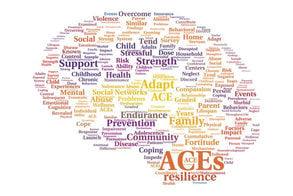 It’s not what’s wrong with you, it’s what happened to you. People consistently show up for therapy thinking they are crazy, inadequate, damaged, abnormal, intrinsically flawed, incomplete, and deficient because they are innately defective. These beliefs are actually the result of adverse childhood experiences and traumatic events. Changing this perspective from “what is wrong with you” to “what happened to you” changes the course of therapy and assists in externalizing negative experiences and cognitions. You are not innately defective. You believe these things about yourself because of a wide variety of adverse experiences that reinforce these beliefs. Need proof? CDC-Kaiser Permanente Adverse Childhood Experiences (ACE) Study is one of the largest investigations of childhood abuse and neglect and later-life health and well-being. It scores the number of adverse childhood experiences a person experiences before the age of 18. There are 10 types of childhood trauma measured in the ACE Study. Five are personal -- physical abuse, verbal abuse, sexual abuse, physical neglect, and emotional neglect. Five are related to other family members: a parent who's an alcoholic, a mother who's a victim of domestic violence, a family member in jail, a family member diagnosed with a mental illness, and the disappearance of a parent through divorce, death or abandonment. The ACE Study reveals a relationship between the number of ACEs and severity of negative health and well-being outcomes across one’s life. As the number of ACEs increases, so does the risk of alcoholism and illicit drug addiction, depression, health-related quality of life, heart disease, liver disease, poor work performance, financial stress, risk for intimate partner violence, sexually transmitted diseases, smoking, suicide attempts, early initiation of sexual activity, adolescent pregnancy, risk for sexual violence, and poor academic achievement. In a nutshell, the adverse experiences present in childhood lead to so much stress on the body and mind creating a whole slew of negative health, mental health, and addiction diagnoses later in life. Changing the focus of therapy from coping with symptoms to healing adverse childhood experience allows the present to be free from the influence of the past.
2 Comments
 My two nephews and I were running around their tiny town, playing hide and seek, exploring, and talking to neighbors. Henry, age six, found a deep pile of leaves in a church yard along a stone wall the boys were walking on and jumped in. Laughing, he kicked around in the leaves for a few minutes. When he climbed back over the wall, ants were crawling all over his calves and shins and into his socks. He panicked, swatting at his legs as tears welled in his eyes. We quickly removed his shoes and socks and brushed the ants off. His tears dried, and we resumed our journey in the direction of his parent’s small health food store where his mom was stationed behind the counter. As I got a drink from the cooler, Henry checked in with his mom and the two boys ran upstairs to play. At the counter paying for my drink, and feeling slightly guilty for allowing her son to play in an anty pile of leaves, I told Emily, my sister in law, about the ants. Emily smiled and said she’d already heard the entire story. She slid coins into the cash drawer, closed it, and we too went on with our day. But the Ant Incident stuck with me. It’s not about ants. It’s about attachment, the single most important parenting practice. More important than healthy food, organic toys, and appropriate pre-school placement. Bonding with an infant is a known practice. Hospitals promote parent and infant contact after birth. Many people recognize the importance of attachment in a person’s first years. However, attachment is a process that continues throughout the life span. A parent who is able to attune themselves to the on-going emotional needs of their child provides a secure emotional base from which the child can explore the world, knowing they have a safe emotional place to return. The connection Henry made with his mother after the Ant Incident is a perfect example of how parents can continue to provide secure attachment. After the Ant Incident Henry and his brother re-engaged and continued their jokes, ribs, and exploration back to their parents where Henry immediately sought his mother’s attention. He told her the story, she validated his fear and provided reassurance – all within a minute. He then ran off again with his older brother. A healthy attachment experience exists inside this seconds-long interaction that provided security, safety, and assurance to Henry. And let me be clear – checking Henry’s legs for ant bites is the least important part of this interaction. The secure attachment between Henry and his mother is exemplified by Henry telling a story about a scary incident to his attachment figure, her listening, nodding in understanding, asking if he is okay, giving a quick hug and putting right to the world. It was focused attention, full engagement, and calm, kind words that happened in a matter of a minute on a typical day in this family’s life. |
Details
Renew BlogDiscover your best self Archives
December 2021
Categories
All
|

 RSS Feed
RSS Feed